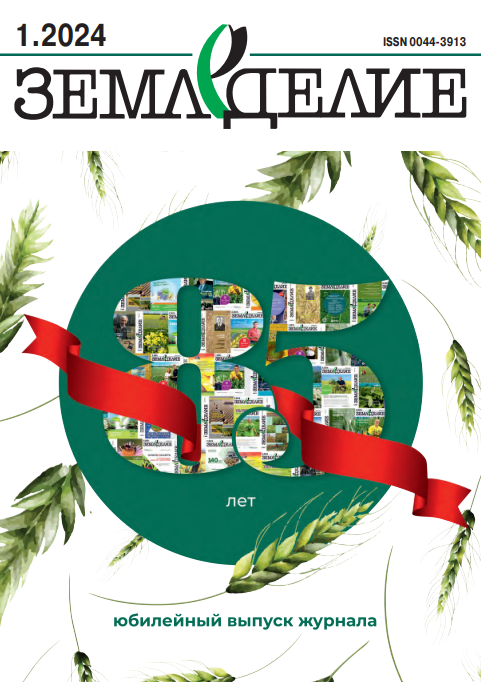Приёмы эффективного снижения водопотребления посевов в кормовых севооборотах
Земледелие, 2017, № 7
УДК 631.582
Р.Ф. ГАЛЕЕВ, кандидат сельскохозяйственных наук, зав. сектором (e-mail: Адрес электронной почты защищен от спам-ботов. Для просмотра адреса в вашем браузере должен быть включен Javascript.)
О.Н. ШАШКОВА, кандидат сельскохозяйственных наук, старший научный сотрудник
Сибирский научно-исследовательский институт кормов СФНЦА РАН, пос. Краснообск, Новосибирский р-н, Новосибирская обл., 630501, Российская Федерация
Исследования проводили в условиях лесостепной зоны Западной Сибири. В стационарном опыте изучали влияние минеральных удобрений и подсева бобового компонента на элементы водного режима чернозёма выщелоченного, водопотребление и продуктивность посевов в шестипольных кормовых севооборотах. В качестве азотного удобрения использовали аммиачную сели- тру, фосфорного – простой суперфосфат. В годы проведения исследований наблюдали контрастные условия по влагообеспеченности вегетационных периодов. В 2011 г. они были близки к среднемноголетним показателям (типичный год, ГТК – 0,9). В 2012 г. осадков выпало на 103 мм меньше средних многолетних значений, среднесуточная температура воздуха была на 2,7 °С выше нормы (засушливый год, ГТК – 0,6). В 2013 г. осадков выпало на 100 мм больше нормы, а температура воздуха была ниже на 0,4 °С среднемноголетнего значения (влажный год, ГТК – 2,3). Минеральные удобрения, подсев бобового компонента, а также их совместное применение оказали существенное влияние на снижение коэффициентов водопотребления посевов в кормовых севооборотах. Эти приёмы в засушливый год, обеспечили расход воды на формирование 1 т сухой массы 42-46 мм, в типичный год – 36- 38 мм, во влажный год – 39-56 мм. В типичный по увлажнению год подсев бобового компонента обеспечивал больший сбор сухой массы, чем внесение минеральных удобрений. Оба приёма повышали величину этого показателя, по сравнению с контрольным севооборотом, в 1,8-2,0 раза (3,92-4,28 т/га). В засушливый вегетационный период действие приёмов было равнозначным, сбор сухой массы составил 1,65-1,82 т/га, что выше контроля в 1,2-1,3 раза. Во влажный год удобрения повышали продуктивность севооборота в 1,6 раза (до 5,97 т/га), а подсев бобового компонента – в 1,5 раза. Результаты исследований рекомендуются для применения в хозяйствах лесостепной зоны Западной Сибири.
Ключевые слова: кормовой севооборот, продуктивная влага, минеральные удобрения, бобовый компонент, продуктивность, суммарное водопотребление, коэффициент водопотребления.
Для цитирования: Галеев Р.Ф., Шашкова О.Н. Приёмы эффективного снижения водопотребления посевов в кормовых севооборотах// Земледелие. 2017. № 7. С. 32-35.
Methods for Effective Reduction of Water Consumption in Fodder Crop Rotations
R.F. Galeev, O.N. Shashkova
Siberian Research Institute of Forages of the SFRCAB of the RAS, pos. Krasnoobsk, Novosibirskii r-n, Novosibirskaya obl., 630501, Russian Federation
The investigation was carried out under conditions of the forest-steppe zone of Western Siberia. In a stationary experiment, it was studied the influence of mineral fertilizers and undersow of a legume component on the elements of the water regime of leached chernozem, water consumption and productivity of crops in 6-field fodder crop rotations. Ammonium nitrate was used as nitrogen fertilizer, standard superphosphate – as phosphoric one. In the years of the research, it was observed contrast conditions at the moisture provision of growing seasons. In 2011, they were close to mean annual rates (a typical year, HTC was 0.9). In 2012, precipitation was 103 mm less than mean annual rates, the average daily air temperature was above the normal one by 2.7 Celsius degrees (a drought year, HTC was 0.6). In 2013, precipitation was more than the norm by 100 mm, and the air temperature was below the mean average value by 0.4 Celsius degree (a wet year, HTC was 2.3). Mineral fertilizers, undersow of the legume component, and their joint application significantly influenced the reduction of the coefficients of water consumption by crops in the fodder crop rotation. These methods provided the water consumption for the formation of one ton of the dry mass of 42–46 mm in the dry year, 36–38 mm in the typical year, and 39– 56 mm in the wet year. In the typical in hydration year, the undersow of the legumes component ensured the higher harvest of dry mass than the application of mineral fertilizers. Both methods increased the value of this index 1.8–2.0 times (3.92–4.28 t/ha) in comparison with the control crop rotation. In the arid vegetation period, the effect of the methods was equivalent, the harvest of dry mass was 1.65–1.82 t/ha, which was 1.2–1.3 times higher than the control. In the wet year, fertilizers increased the productivity of the crop rotation 1.6 times (up to 5.97 t/ha), and the undersow of the legume component – 1.5 times. The results of the investigation are recommended to be applied in the farms of the forest-steppe zone of Western Siberia.
Keywords: fodder crop rotation, productive moisture, mineral fertilizers, legume component, productivity, total water consumption, water consumption coefficient.
Author Details: R.F. Galeev, Cand. Sc. (Agr.), head of division (e-mail: onklin@mail. ru); O.N. Shashkova, Cand. Sc. (Agr.), senior research fellow.
For citation: Galeev R.F., Shashkova O.N. Methods for Effective Reduction of Water Consumption in Fodder Crop Rotations. Zemledelie. 2017. No. 7. Pp. 32-35 (in Russ.).










